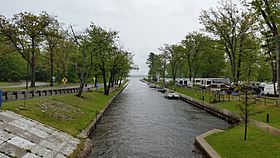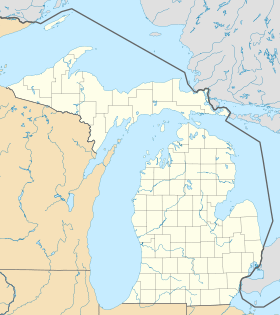Mitchell State Park facts for kids
Quick facts for kids William Mitchell State Park |
|
|---|---|
|
IUCN Category III (Natural Monument)
|
|

Clam Lake Canal with campground on the right
|
|
| Location | Cadillac, Wexford County, Michigan, United States |
| Area | 334 acres (135 ha) |
| Elevation | 1,289 feet (393 m) |
| Designation | Michigan state park |
| Established | 1920 |
| Named for | William W. Mitchell |
| Visitors | 155,633 (in 1996) |
| Administrator | Michigan Department of Natural Resources |
| Website | William Mitchell State Park |
William Mitchell State Park is a fun outdoor spot in Cadillac, a city in northern Michigan. This park covers about 334 acres (135 ha) of land. It sits right between two beautiful lakes: Lake Mitchell and Lake Cadillac.
A special waterway called the Clam Lake Canal runs right through the park. This canal is about one-third of a mile long. It connects Lake Mitchell and Lake Cadillac. The canal was dug way back in 1873. It helped move cut trees from Lake Mitchell to sawmills on Lake Cadillac. This made it easier to turn trees into lumber.
Contents
Park History and Naming
This park is named after William W. Mitchell. He was a businessman who ran sawmills in the area in the 1890s. He was also the nephew of George A. Mitchell, who helped start the city of Cadillac.
How the Park Started
The park first opened in 1920. It was one of 13 parks created after the Michigan State Parks Commission began. At first, it was called Cadillac State Park.
A Special Gift
The land for the park was a gift from William Mitchell's wife, Ellen. She asked that the park be named after her husband. This is how it became William Mitchell State Park.
What You Can See and Do
William Mitchell State Park has many cool things to explore. It's a great place for outdoor adventures.
Carl T. Johnson Center
Inside the park, you'll find the Carl T. Johnson Hunting and Fishing Center. This center teaches visitors about the history of hunting and fishing. It also has workshops and presentations. You can see exhibits of local wildlife species here too.
Outdoor Fun and Trails
The park offers a big campground with 221 spots for tents or RVs. There are also cabins you can rent. If you love the water, there are two boat launches. Kids can enjoy the playground and a sandy beach. There are also picnic areas for meals outdoors.
You can go fishing for different kinds of fish. These include perch, walleye, panfish, and bass.
Heritage Nature Trail
The park has a 2.5-mile (4.0 km) long path called the Heritage Nature Trail. This trail goes through woodlands and marshy areas. It's mostly a woodchip path with bridges and boardwalks. It's a great spot to see different plants and wildlife.
Winter Activities
When winter comes, the park is still full of fun. You can go snowmobiling or try ice fishing. Snowshoeing and cross-country skiing are also popular activities.


